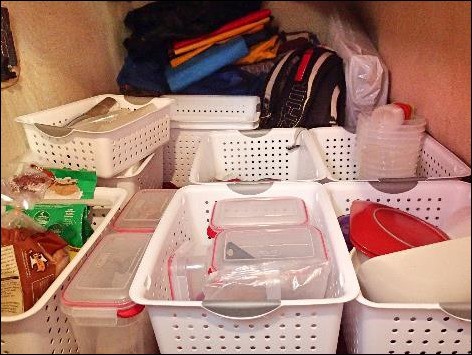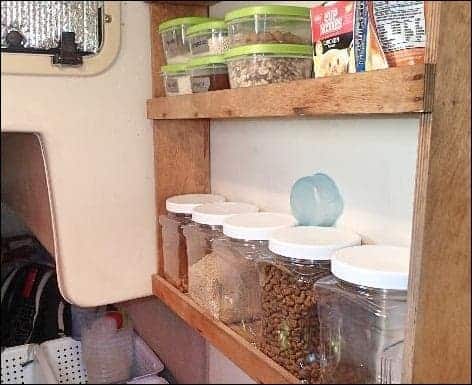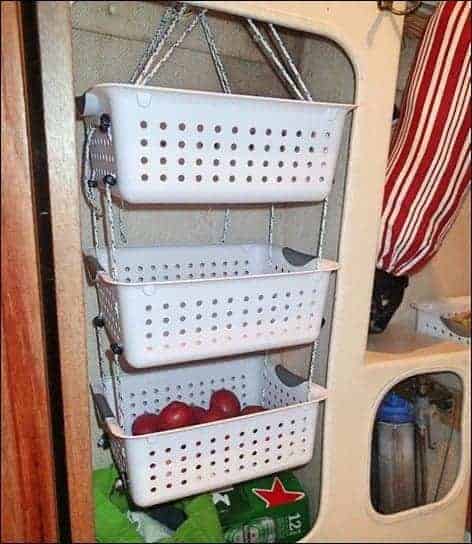
Knowing just how to stow provisions on a boat is always tough, with having to find room for everything. But then there’s a secondary consideration. Weight distribution – and management – is important on any boat, but particularly for a lightweight catamaran. And Barefoot Gal is a lightweight catamaran.
So in provisioning her, I’ve tried not to stock up too much (we are in the US, after all), planning to hit the supermarket about once a week while we’re in the boatyard as the store is nearly half an hour away. Once we’re on the water, I’ll probably try to hit a store every week to 10 days, and carry a few extra days’ supplies “just in case.”
This is a big change from our cruising aboard Que Tal in the Sea of Cortez and south along the Mexican/Central American coast. There, we’d plan to go three weeks between grocery stops, and I knew that there were some things that I wouldn’t find outside major cities and would stock up on for three or four months. But Que Tal was a heavy Tayana 37 and could carry a lot.
But it’s not just the weight of the provisions we need to stow on the boat, it’s where that weight gets stowed. Sailboats sail, motor and steer best when the weight is concentrated in the center of the boat, both fore-and-aft and side-to-side. Side to side, you want the weight to be fairly evenly distributed, too, so the boat doesn’t list one way or the other. And the lower the weight is, the better. Paying attention to the weight distribution not only makes the boat sail/motor better (read: faster) but also with an easier motion and more responsive steering.
All that, of course, has to be tempered by convenience. Here’s my arrangement so far, along with the why (update: some things have been moved; see the current arrangement here):

In the galley, there are two main storage areas in a Gemini: a large locker under my drying dishes, and behind the sliding doors (which extends under the settee). These are the most centered areas to store provisions and hence I wanted to put the heaviest items here.
The locker next to the sink is a pain to get into when cooking, simply because it’s under the main food prep counter. So I put all of our cleaning supplies in here – they are mostly liquids and hence heavy, and I’m almost never going to be getting them out when I’m cooking.
I put several bins in the forward bottom slider and put canned goods and other “heavy” items such as peanut butter and olive oil in them. The top sliders only go back a few inches and so I put Ziploc bags, trash bags, stove lighters and other small items in them.
The rear (towards the camera) slider I decided to use for baking supplies and pans. Things like flour and sugar that are fairly heavy, although I admit my plastic mixing bowl set isn’t – but it fits well in there and is convenient.
Most boats that we looked at when we were boat shopping had the dishes in these sliders, but as my dishes are lightweight (but nice) plastic ones, it seemed better to me to put something heavier there. And frankly, with the narrow passageway in front of the slider, it can be a pain to find dishes in the back of that locker.
The cabin just aft of the galley is known amongst most Gemini owners as “the pantry” and ours is no exception. As the bed is actually narrower than a double, we don’t really expect to use it for guests.

At the far back, you can see (very lightweight) extra bedding and dry bags. In the middle (from left in the photo) are paper products (TP, paper towels, plastic bags), snacks and empty food storage containers. Easiest to get to (closest to the camera) are the bins with bread and chips, a couple of containers of crackers, a bin with cereal and one with our dishes (very accessible which I love since they’re the item I use most often).
It’s all fairly lightweight and using the bins both keeps it neat and makes it easy to move if/when we need to get to the water tank and watermaker under the bed.

Progressing forward in the cabin (towards the galley), a previous owner built a small shelf area. I managed to find some canisters that would fit (not my favorite locking type but size was the key here) and will put shock cord retainers across them before we get underway (done – see them here). The ones on the upper shelf are Rubbermaid Easy-Find Lid containers and while they don’t lock, they do snap together on top of each other so that a retaining strap will hold them.
Here, I’ve put things such as pasta, rice, dog kibble, nuts, panko breading and couscous. Not super-light, but not very heavy, either, as it’s up in the air.
There’s a very shallow drawer a foot or so below this, where 12 boxes of soy milk fit perfectly – great to have heavy items low and towards the center of the boat.
And on the hull side, there are my hanging produce baskets with soft drinks and beer under them, in what was designed as a hanging locker.

So there you have it. Not 100% driven by weight, but an important consideration along with what I wanted to have most easily available. A little different than where things might seem to go, but it’s working well so far.
More About Storing Provisions

Carolyn Shearlock has lived aboard full-time for 17 years, splitting her time between a Tayana 37 monohull and a Gemini 105 catamaran. She’s cruised over 14,000 miles, from Pacific Mexico and Central America to Florida and the Bahamas, gaining firsthand experience with the joys and challenges of life on the water.
Through The Boat Galley, Carolyn has helped thousands of people explore, prepare for, and enjoy life afloat. She shares her expertise as an instructor at Cruisers University, in leading boating publications, and through her bestselling book, The Boat Galley Cookbook. She is passionate about helping others embark on their liveaboard journey—making life on the water simpler, safer, and more enjoyable.
Simplify meal prep on board with proven strategies for provisioning, maximizing fridge space, and cooking delicious meals aboard your boat.










Bruce Comeau says
WOW that brought back memories of my trimaran.
Gerald Hemming says
When you pack do you pack for 30 days, the first passage or do you plan to not reprovision until you get home?
The Boat Galley says
We’re living aboard for 6+ months over the winter. I provision for about a week to 10 days at a time, or longer if we plan to be away from store for longer. I reprovision wherever we are, not necessarily at a “home base.”
Barbara K says
What are shock cord retainers? And what kind of retaining straps do you use? And where did you get the block clips that hold the baskets up on the ropes on the hanging baskets?
Carolyn Shearlock says
Shock cord retainers — that’s what I call stretching a piece of shock cord (bungee cords) across something to keep it in place. Often has loops on the ends to hook on cup hooks or other hooks.
I’ll write a post with pictures when I get them made — right now, I’m waiting for the shock cord to be sent to me.
As for the cord locks on the hanging produce bin, I bought mine at Walmart in the camping department, but you can get them cheaper on Amazon. Here’s my post with instructions for how to make them, along with a link to buy the cord locks:
Make Hanging Produce Baskets
Barbara K says
Thank you! Great information!